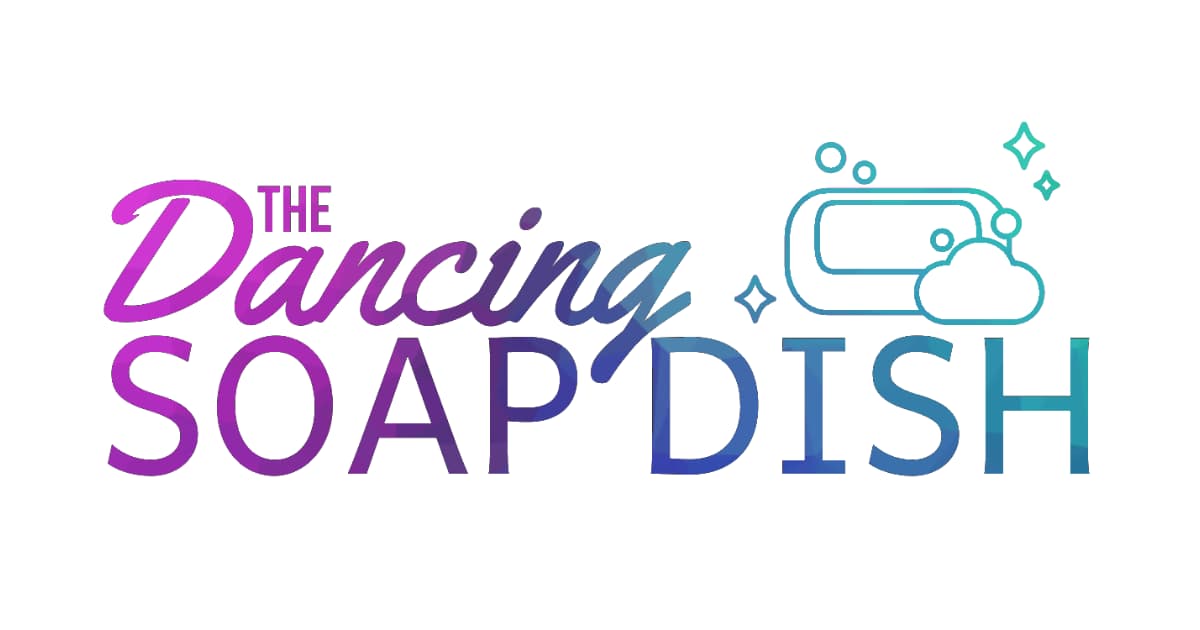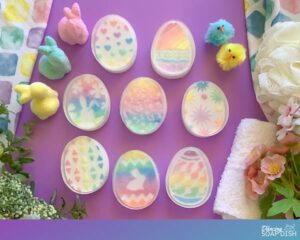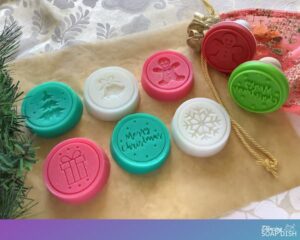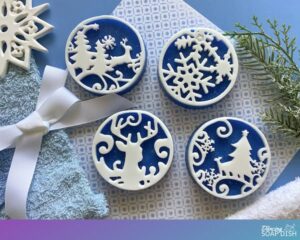This basic mosaic soap beginners project demonstrates how to make two simple floral and two geometric mosaic soap designs.
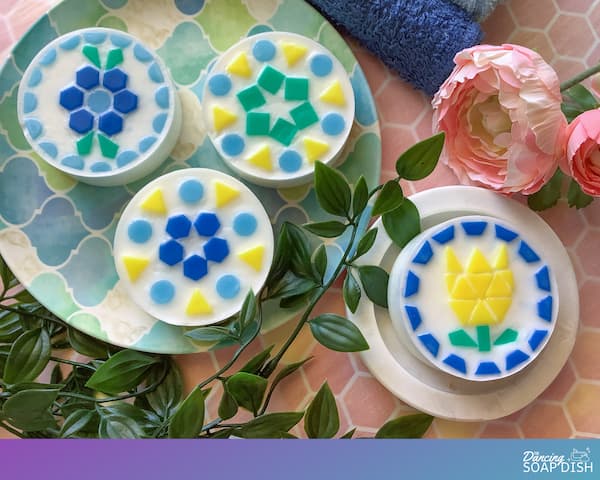
This post contains affiliate links. If you buy something through one of those links, I will receive a small commission at no extra cost to you. As an Amazon Associate I earn from qualifying purchases.
Thank you for supporting my site!
Table of Contents
My Inspiration for Basic Mosaic Soap
What You Need to Make Basic Mosaic Soap
Basic Mosaic Soap Video Tutorial
Basic Mosaic Soap Instructions and Printable Tutorial
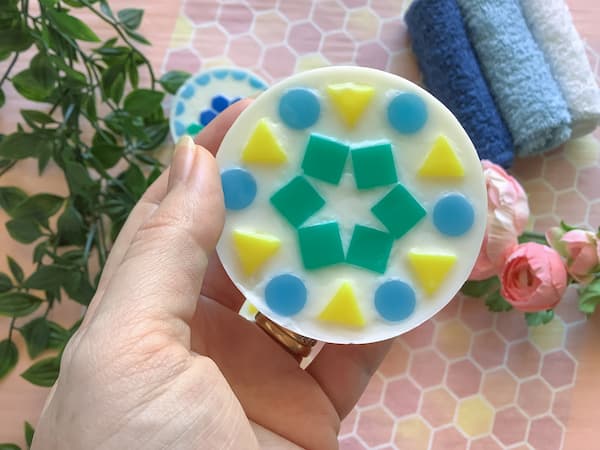
My Inspiration for Basic Mosaic Soap
For the first month of our 2023 Mosaic Soap Challenge I wanted to start with a basic beginners project.
A finished mosaic soap bar can look quite complex, but the process is actually quite simple.
This project demonstrates the ‘grout surround’ mosaic soap method which consists of a simple mosaic picture or pattern laid out on a soap ‘base’, and then surrounded by white ‘soap grout’.
I chose two simple floral designs and two simple geometric designs using four different colours.
If you can follow this simple method then you can make pretty much any mosaic design.
Let’s get started!
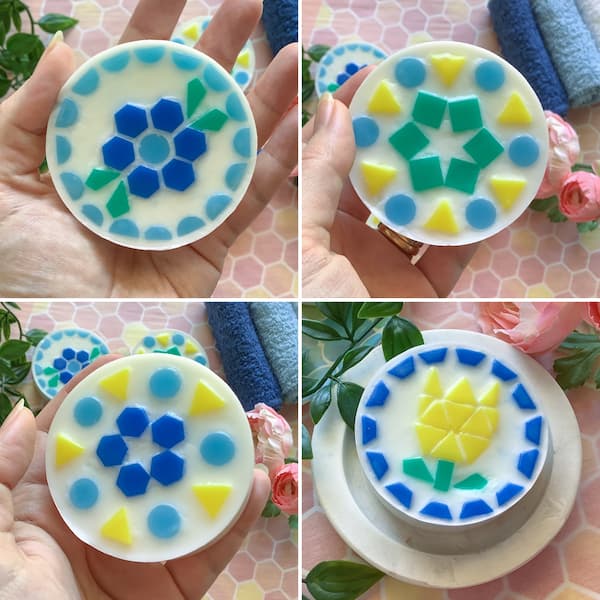
What You Need to Make Basic Mosaic Soap
Melt and Pour Soap Base
Melt and pour soap is sold as large blocks that you can cut up and then weigh out the amount of soap you need.
I used white melt and pour soap base and clear melt and pour soap base to make my basic mosaic soap bars. Each of my bars weighs approximately 80g (~2.8oz).
I used white melt and pour soap base for the base bars and soap ‘grout’.
The mosaic soap tiles are a combination of white and clear melt and pour soap base at a 20/80 ratio as I wanted them to have a vibrant colour but still be opaque.
Don’t forget to add up to 5% for wastage.
Soap Moulds
To make mosaic melt and pour soap bars you need two moulds, one for the tiles and one for the base.
This mosaic tile mould makes six different patterns of mosaic tiles. For this project, I’m using the geometric shapes (hexagon, square, circle and triangle) and leaving the abstract shapes for another day.
Live outside of the United States? You can also buy this mosaic tile mould from Aliexpress.
For the base, a mould that is a basic, geometric shape such as a circle, square or rectangle is ideal.
I used this circular silicone soap mould for my project, but you can use any other geometric soap mould you have on hand.
Plastic or Rubber Scraper
You will find filling the mosaic tile silicone mould much easier if you have a rubber scraper on hand to distribute the melted soap base evenly across the mould.
Live outside of the United States? You can also buy rubber scrapers from Aliexpress.
Soap Colouring
I used royal blue, green, light blue and yellow soap colouring for my basic mosaic soap bars. I prefer liquid soap colouring, but you can also use coloured mica.
Essential Oils or Fragrance Oils
Scenting your soap is optional, but most of us prefer a pretty smelling soap bar.
For this project, I used doTERRA’s Serenity essential oil blend, but you can feel free to use your favourite combination of essential oils or your preferred fragrance oil.
If you are looking for ideas, check out my list of perfect essential oil soap scents.
Small Glass Measuring Cup
I highly recommend using a small glass measuring cup to pour the mosaic tiles and the white ‘grout’ surround. An espresso measuring cup (used by baristas) is ideal as it has a double spout, a wooden handle, and can withstand high heat.
Live outside of the United States? You can also buy espresso measuring cups from Aliexpress.
Alcohol in a Small Spray Bottle
Alcohol (rubbing alcohol/isopropyl alcohol or vodka) has a number of uses when making melt and pour soap:
- Spraying the soap with alcohol once it’s poured will remove any bubbles sitting on the soap’s surface.
- Spraying alcohol between soap layers helps them adhere together.
- Spraying the soap mould with alcohol before pouring the soap helps the soap spread evenly across the bottom of the mould.
Alcohol is an absolute MUST when making mosaic soap as it helps the soap ‘grout’ fill the gaps between the soap mosaic tiles.
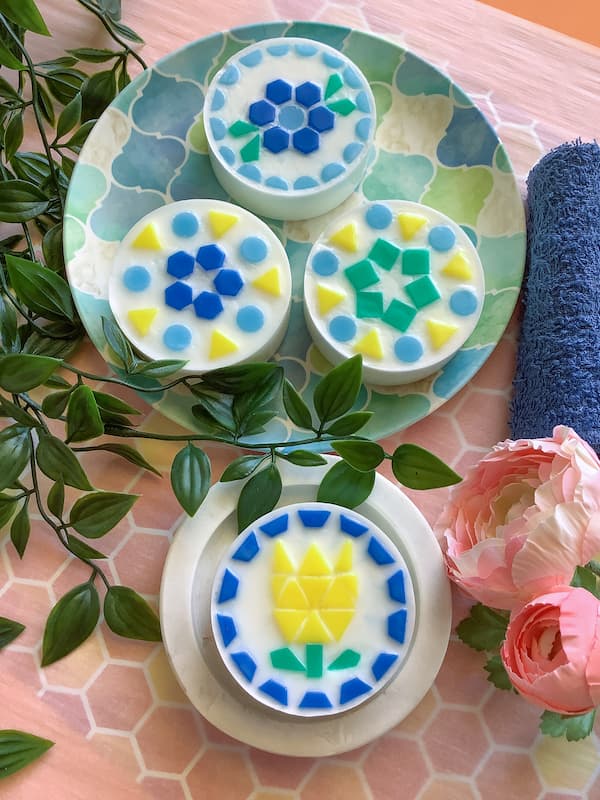
Additional Materials Required
Kitchen Scales – I’ve used grams in this recipe because the amounts are easier to manage compared with ounces. Most kitchen scales these days are interchangeable between grams and ounces. Check your scale’s instruction booklet for how to change your scale to measure in grams and then change it back when finished.
Glass Measuring Jug – You will need a larger (500ml/16oz) measuring jug to melt the white melt and pour soap base. I have a separate glass measuring jug dedicated to creative projects (soap making, lotion bars, lip balm etc) to avoid any cross-contamination of non-ingestible ingredients with food. I recommend you do the same.
Metal or Bamboo Skewer – Skewers are super handy for positioning the mosaic tiles. They can also be used for stirring the melted soap base and can be easily cleaned or disposed of.
Paper Cups – I used paper cups to mix and pour the coloured soap base for my mosaic soap tiles. A paper cup can also be used to collect any unused soap base after you have poured your base bars, mosaic soap tiles, and soap ‘grout’.
A Tray Lined with Greaseproof Baking Paper – Position the silicone soap moulds on a piece of greaseproof baking paper on a tray before pouring to allow for easy cleaning up (there will be drips) and transport while the soap is setting.
Plastic Tweezers – A pair of plastic tweezers are recommended to help position the soap mosaic tiles.
A Breadboard and a Sharp Knife – For cutting mosaic soap tiles into different shapes.
Cotton Buds – You will require cotton buds/swabs during the soap ‘grouting’ stage to clean up any white soap base spilled on the mosaic soap tiles.
Microwave or Double Boiler – Melt your soap base in either a microwave and/or a double boiler. A double boiler is recommended for this project to ensure your soap base stays hot while you work.
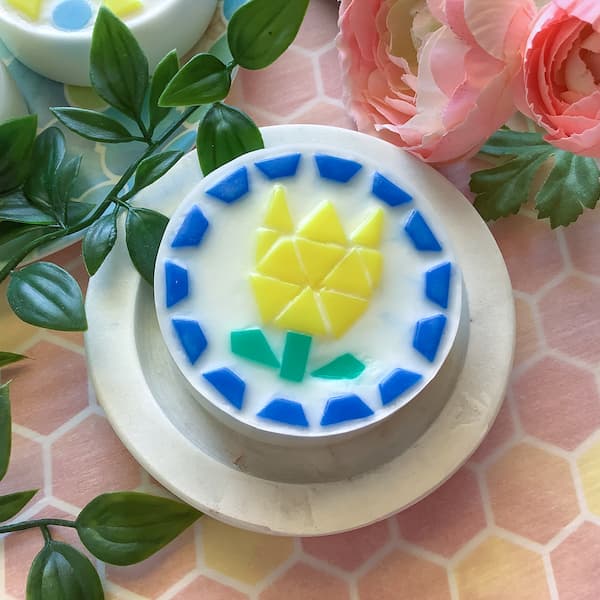
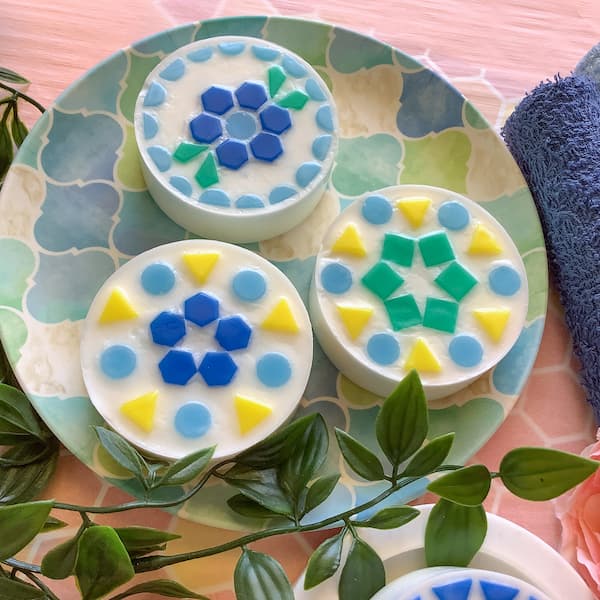
Basic Mosaic Soap Video Tutorial
To make it easier for you to grasp the process, I created a video tutorial about how to make basic mosaic soap bars.
How to Make Basic Mosaic Melt and Pour Soap Bars
Want your Basic Mosaic soap to look like mine?
I made four, round, soap bars from white melt and pour soap base scented with doTERRA’s Serenity essential oil blend to use as the bases for each of my mosaic soaps.
I then used a combination of clear melt and pour soap base and white melt and pour soap base to make dark blue hexagon, green square, light blue circle, and yellow triangle mosaic tiles using a mosaic tile silicone mould.
I positioned the mosaic soap tiles (in basic floral and geometric patterns) on top of the round base bars.
Finally, I scented a small amount of white melt and pour soap base and poured it around the mosaic soap tiles to ‘grout’ them in.
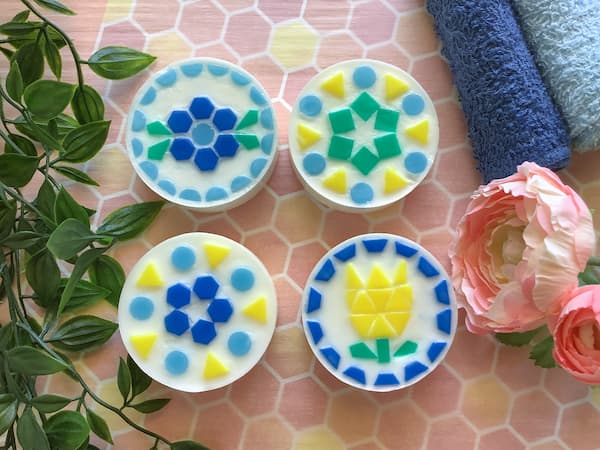
Basic Mosaic Soap Bars Printable Tutorial

Basic Mosaic Soap Bars
Equipment
- Alcohol in a Small Spray Bottle (rubbing alcohol, isopropyl or vodka)
- Kitchen Scales
- Glass Measuring Jug
- Plastic Tweezers
- Bamboo or Metal Skewer
- A Pair of Scissors
- Tray lined with Grease-Proof Paper
- A Breadboard and a Sharp Knife
- Cotton Buds (Q-Tips)
- Paper Cups (4 for soap making, 3 for leftover soap base)
- Microwave or Double Boiler
Ingredients
- 395 g White Melt and Pour Soap Base (plus up to 5% for wastage)
- 70 g Clear Melt and Pour Soap Base
- Mosaic Tile Silicone Mould
- Round Soap Mould
- Rubber Scraper
- Small Glass Measuring Cup
- Soap Colouring
- Soap Fragrance or Essential Oils (optional)
Instructions
- Set out all of your equipment and ingredients ready to be used.
- Weigh out 325g (~11 ½oz) of white melt and pour soap base and cut it up into small cubes.
- Put the soap cubes in a glass measuring jug and add another cube (up to 5%) for wastage.
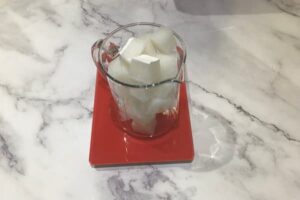
- Weigh out 70g (~2 ½oz) of clear melt and pour soap base and cut it up into small cubes (this includes wastage).
- Put the clear soap base cubes in a small glass measuring cup with a pouring spout.
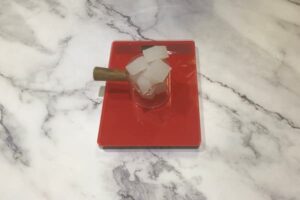
- Melt your soap bases as per the instructions in a microwave or double boiler. Regardless of the melting method, it is recommended you keep your soap bases on a double boiler to keep them warm.
- Place a four-cavity, round soap mould on a tray lined with grease-proof paper and position it on top of a set of kitchen scales and press TARE.
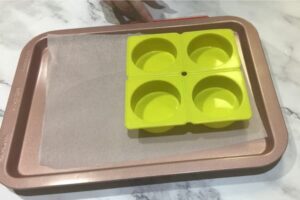
- Scent your soap with fragrance oils or essential oils (optional).
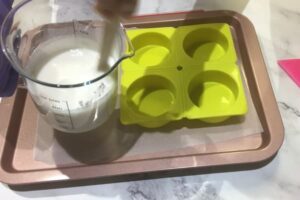
- Pour 70g of liquid soap base into each cavity, resetting the scales to ‘0’ between pouring each cavity.
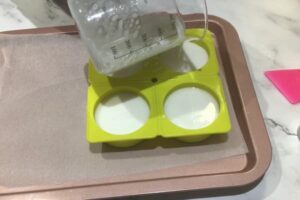
- Spray the surface of the soap with alcohol to remove any bubbles.
- Place the mosaic tile silicone mould on a tray lined with greaseproof baking paper.
- Place a paper cup on a set of kitchen scales.
- Weigh out 15g of clear melted soap base and 5g of white melted soap base into the paper cup.
- Add royal blue soap colouring and mix well.
- Pinch the rim of the paper cup to make a pouring spout and pour the soap base into the hexagon-shape section of the mosaic tile silicone mould.
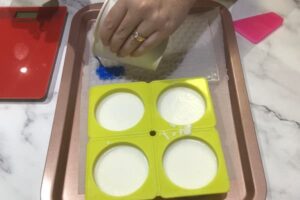
- To ensure all of the tile cavities are filled evenly, spread the soap base around with a rubber scraper and spray alcohol to break the surface tension and remove any bubbles.
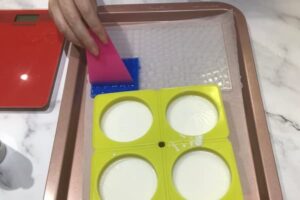
- Repeat steps 12-16 to make green square soap tiles, light blue circle soap tiles, and yellow triangle soap tiles.
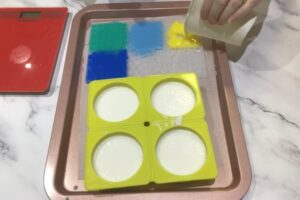
- Pour any remaining soap base into a paper cup to be used again later (optional).
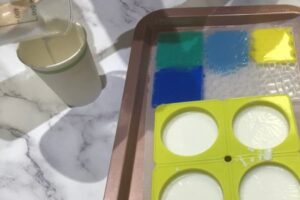
- Set the soap aside to set for 1 hour.
- Once the soap is set, turn the mosaic tile mould over and push out the mosaic soap tiles onto the paper-lined tray while bending and flexing the mould.
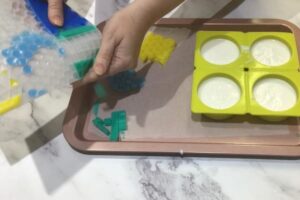
- Separate and sort the soap tiles by shape into separate piles.
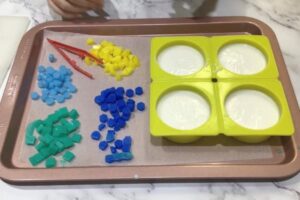
- Check that your round, base soap bars are set enough that the surface of each bar is hard to the touch.
- Start assembling mosaic tile designs in the centre of each round bar. Add a border if desired.
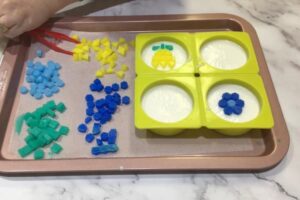
- Use a pair of scissors to trim the edges of the mosaic soap tiles (if necessary) as you go.
- Use a breadboard and a sharp knife to cut the mosaic soap tiles down to different shapes if required.
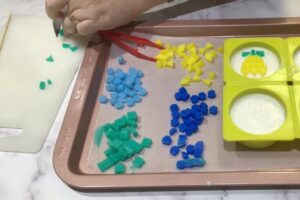
- Use a pair of plastic tweezers and a metal or bamboo skewer to carefully push all the mosaic soap tiles to exactly where you want them positioned.
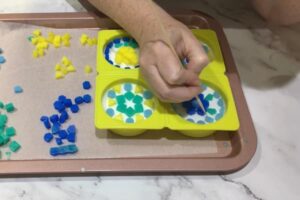
- Weigh out 70g (~2 ½ oz) of white melt and pour soap base and cut it up into small cubes. Include any leftover soap base saved from earlier if available.
- Put the soap cubes in a small glass measuring jug with a pouring spout.
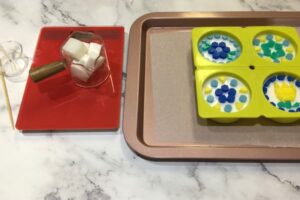
- Melt your soap base as per the instructions in a microwave or double boiler (for this part of the process a double boiler is recommended).
- Scent your soap with fragrance oils or essential oils (optional).
- Spray the surface of your mosaic soap designs with alcohol to help the soap layers adhere to each other.
- With your melted soap base in one hand, and your spray bottle of alcohol in the other, gently pour the liquid soap base around the mosaic soap tiles to ‘grout’ them into place.
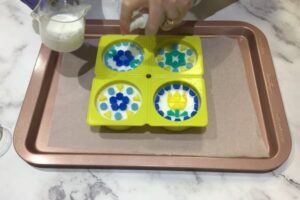
- As you pour, spray the soap with alcohol to help it fill the small gaps between the mosaic soap tiles, and to remove any bubbles.
- Clean up any white soap spilled on top of the coloured mosaic soap tiles immediately with a cotton bud dipped in alcohol.
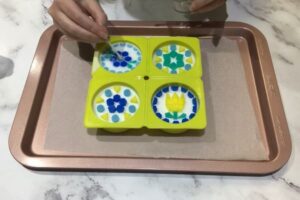
- Once all four soap bars have been ‘grouted’ pour any remaining white soap base into a paper cup to be used again later (optional).
- Allow the soap bars to set overnight and then demould them by pushing from the bottom as you peel back the silicone mould.
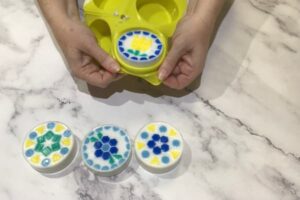
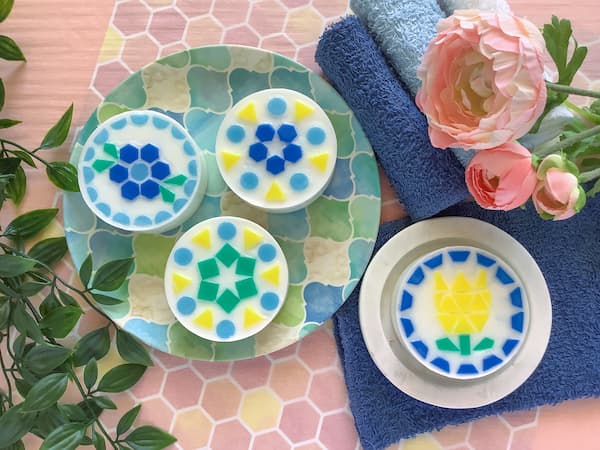
Enjoy!
